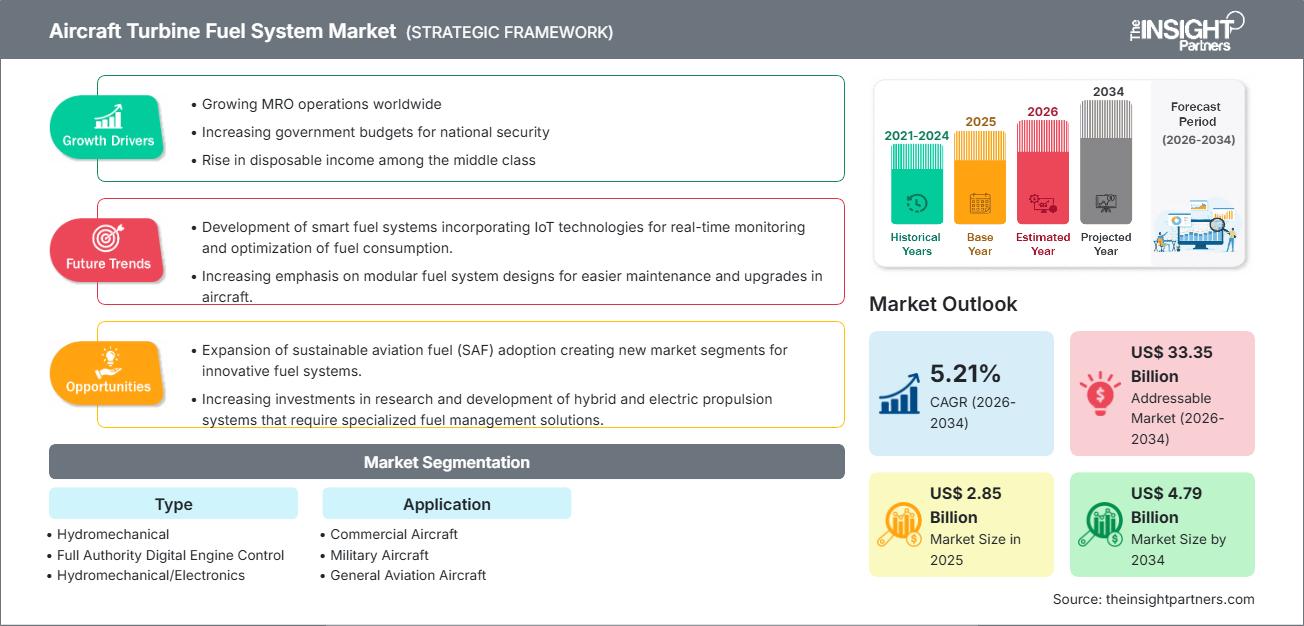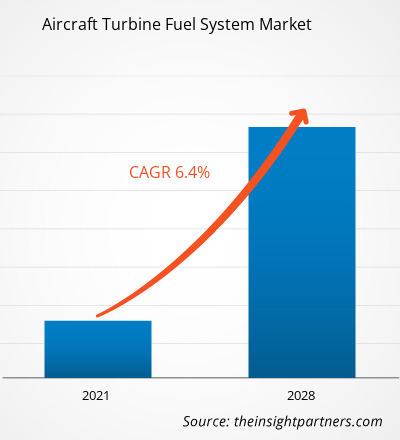航空機タービン燃料システム市場規模は、2025年の28億5,000万米ドルから2034年には47億9,000万米ドルに達すると予想されています。市場は2026年から2034年の間に5.21%のCAGRを記録すると予想されています。
航空機タービン燃料システム市場分析
航空機タービン燃料システム市場は、世界的な航空旅行の増加と、運用効率向上のための積極的な航空機近代化プログラムに牽引され、着実な成長が見込まれています。この成長は、SAF(燃料噴射装置)の導入、水素推進システムの開発、そして厳格な国際排出ガス規制といった世界的な持続可能性への取り組みによってさらに後押しされる可能性があります。さらに、環境コンプライアンスと燃費効率へのこうした重点は、FADEC(燃料噴射装置)や高度電子式計量システムにおけるイノベーションを推進し、民間航空と軍用航空の両方の将来性をさらに強化しています。
航空機タービン燃料システム市場の概要
航空機タービン燃料システムは、ポンプ、計量ユニット、フィルター、FADECシステムなど、ジェットエンジンへの燃料の正確な貯蔵、調整、供給を担う、極めて重要な複雑な部品アセンブリです。これらのシステムは、飛行の安全性、最適なエンジン性能、そして進化する環境基準への適合にとって極めて重要です。優れた効率性、診断機能、そして新しい燃料タイプへの対応柔軟性を提供するため、従来の油圧機械式ユニットに代わり、最新の電子式およびハイブリッド式の燃料管理システムが採用されるケースが増えており、あらゆるセグメントの次世代航空機にとって不可欠なものとなっています。
要件に合わせてレポートをカスタマイズ
このレポートの一部、国レベルの分析、Excelデータパックなど、あらゆるレポートを無料でカスタマイズできます。また、スタートアップや大学向けのお得なオファーや割引もご利用いただけます。
航空機タービン燃料システム市場:戦略的洞察

-
このレポートの主要な市場動向を入手してください。この無料サンプルには、市場動向から見積もりや予測に至るまでのデータ分析が含まれます。
航空機タービン燃料システム市場の推進要因と機会
市場の推進要因:
- 世界的な航空旅行と航空機の拡張の増加: 旅客および貨物の航空交通の持続的な回復と成長、および大規模な軍事近代化プログラムにより、新規航空機の注文に対して信頼性が高く高性能な燃料システムを提供することが必要になっています。
- 燃料効率と排出ガス制御に関する規制義務: ICAO や EU などの機関による世界レベルの厳格な規制により、航空機メーカーは燃焼を制御し環境への影響を軽減するために高度な FADEC と電子システムを導入するよう求められています。
- 老朽化した航空機の近代化と改修: 古い商用航空機や軍用航空機を、より新しく、より効率的で、SAF と互換性のある燃料システムにアップグレードする動きにより、アフターマーケット分野で大きな需要が生まれています。
市場機会:
- 持続可能な航空燃料 (SAF) と水素推進の採用: 代替燃料への移行により、ベンダーには、SAF と極低温水素を処理できる新しい完全に互換性のある燃料計量、ポンプ、および不活性化システムを開発し、認証する大きなチャンスが生まれます。
- 高度な FADEC および電子燃料計量システムの開発: 電子制御ユニットとハイブリッド システムに対する継続的な研究開発により、より正確な燃料管理、適応型エンジン制御、および燃料燃焼のさらなる削減を実現できます。
- スマート センサーと予測メンテナンス テクノロジーの統合: 燃料システムにセンサー ベースの診断機能と IoT 接続を実装すると、プロアクティブなメンテナンス計画がサポートされ、予定外のダウンタイムが削減され、航空会社の全体的な運用信頼性が向上します。
航空機タービン燃料システム市場レポート:セグメンテーション分析
市場シェアは様々なセグメントにわたって分析され、その構造、成長の可能性、そして新たな技術トレンドをより明確に理解するのに役立ちます。以下は、ほとんどの業界レポートで使用されている標準的なセグメンテーション手法です。
タイプ別
- 油圧機械
- フルオーソリティデジタルエンジンコントロール(FADEC)
- 油圧機械/電子工学(ハイブリッドシステム)
アプリケーション別
- 民間航空機
- 軍用機
- 一般航空機
地理別:
- 北米
- ヨーロッパ
- アジア太平洋
- 南米と中央アメリカ
- 中東・アフリカ
航空機タービン燃料システム市場の地域別分析
予測期間全体を通して航空機タービン燃料システム市場に影響を与える地域的な動向と要因は、The Insight Partnersのアナリストによって徹底的に解説されています。このセクションでは、北米、ヨーロッパ、アジア太平洋、中東・アフリカ、中南米における航空機タービン燃料システム市場のセグメントと地域についても説明します。
航空機タービン燃料システム市場レポートの範囲
| レポート属性 | 詳細 |
|---|---|
| 2025年の市場規模 | 28億5000万米ドル |
| 2034年までの市場規模 | 47億9000万米ドル |
| 世界のCAGR(2026年~2034年) | 5.21% |
| 履歴データ | 2021-2024 |
| 予測期間 | 2026~2034年 |
| 対象セグメント |
タイプ別
|
| 対象地域と国 |
北米
|
| 市場リーダーと主要企業の概要 |
|
航空機タービン燃料システム市場のプレーヤー密度:ビジネスダイナミクスへの影響を理解する
航空機タービン燃料システム市場は、消費者嗜好の変化、技術の進歩、製品メリットへの認知度の向上といった要因によるエンドユーザー需要の増加に牽引され、急速に成長しています。需要の増加に伴い、企業は製品ラインナップの拡充、消費者ニーズへの対応のための革新、そして新たなトレンドの活用を進めており、これが市場の成長をさらに加速させています。

- 航空機タービン燃料システム市場のトップキープレーヤーの概要を入手
航空機タービン燃料システム市場シェアの地域別分析
北米
- 市場シェア: 大手機体 OEM の存在、高い防衛費、広範な改修プログラムをサポートする高度な MRO (メンテナンス、修理、オーバーホール) 機能により、世界最大のシェアを保持しています。
- トレンド: 予測メンテナンス技術の積極的な導入と、FADEC システムと高度な航空電子工学プラットフォームの統合に重点が置かれています。
ヨーロッパ
- 市場シェア: 欧州の大手航空宇宙および防衛関連請負業者の支援を受け、持続可能航空燃料 (SAF) と水素推進システムに重点を置いた強力な研究開発イニシアチブにより、大きなシェアを獲得しています。
- トレンド: 厳格な EU 規制を満たす、環境に適合した次世代燃料システムの開発におけるリーダーシップ。
アジア太平洋
- 市場シェア: 中国やインドなどの高成長国における商業航空機の大規模な拡大と、地域内の航空旅行需要の増加により、最も急速に成長する地域になると予測されています。
- 傾向: MRO 施設への大規模なインフラ投資と、燃費の良い新型航空機モデルの調達の増加。
南米と中央アメリカ
- 市場シェア: 地域航空会社の航空機群の近代化と軍事調達プログラムへの政府投資により着実に成長している新興市場。
- トレンド: 地域航空および一般航空の航空機向けのコスト効率が高く信頼性の高い燃料システム ソリューションに重点を置きます。
中東およびアフリカ
- 市場シェア: 航空ハブへの大規模なインフラ投資と、最新の航空機技術を必要とする大手国際航空会社の拡大により、大きな成長の可能性を秘めた発展途上の市場。
- トレンド: 多様で厳しい環境条件下でも最適に機能する、高度で信頼性の高い燃料システムに対する需要が高まっています。
航空機タービン燃料システム市場のプレーヤー密度:その影響を理解する
航空機タービン燃料システム市場は、安全認証(FAA、EASAなど)取得に伴う参入障壁の高さと開発サイクルの長さから、中程度の統合化が進んでいます。イートン、ハネウェル、パーカー・ハネフィン、サフラン、ウッドワードといったグローバル企業が、主要な機体OEMとの既存の関係を活用し、市場を支配しています。
この競争環境により、ベンダーは次のような差別化を迫られています。
- 将来の脱炭素化規制に準拠し、次世代航空機プラットフォームでの地位を確保するために、SAF と水素対応燃料システムを継続的に統合します。
- 地元の MRO プロバイダーおよび防衛請負業者との戦略的パートナーシップを通じて、急成長する新興市場への拡大。
- 優れたエンジン管理、診断、運用コスト削減を実現する高度な FADEC および電子制御テクノロジの開発。
航空機タービン燃料システム市場で事業を展開する主要企業
- イートン
- ハネウェルインターナショナル株式会社
- ジホストロイ
- マスコット・イクイップメント社
- パーカー・ハネフィン社
- サフラン
- トライアンフグループ株式会社
- タービン燃料システムズ株式会社
- ウッドワード株式会社
免責事項:上記の企業は、特定の順序でランク付けされているわけではありません。
航空機タービン燃料システム市場のニュースと最近の動向
- イートンは、EUが資金提供する水素電気推進システムの開発を目的としたHYLENA研究開発プロジェクトに参加しました。イートンは、CO₂排出ゼロの短・中距離飛行を実現するため、固体酸化物燃料電池とターボ機械の統合に焦点を当てたHYLENAプロジェクトへの参加を発表しました。また、持続可能な航空燃料(SAF)に対応した先進的な燃料ポンプと燃料供給システムの供給も継続しています。
- ハネウェルはUOP eFining™技術を発表し、SAFテクノロジーアライアンスを結成しました。ハネウェルは、eメタノールをeSAFに変換するプロセスであるUOP eFining™を発表し、温室効果ガス排出量を最大88%削減しました。さらに、ハネウェルはジョンソン・マッセイ、ギダラ・エナジー、サムスンE&Aと提携し、バイオマスからSAFへのエンドツーエンドのソリューションを提供するSAFテクノロジーアライアンスを結成しました。
- サフランは、BeautHyFuelプロジェクトにおいて、水素燃料タービンエンジンの地上試験に成功しました。サフランは、水素燃料タービンエンジンの試験という重要なマイルストーンを達成するとともに、持続可能な推進技術へのコミットメントを改めて表明しました。また、民間航空機および軍用航空機向けのバイオ燃料対応燃料供給・管理システムも展示しました。
- パーカー・ハネフィンは、エアバス A350 および COMAC C919 の燃料システムに関する数十億ドル規模の契約を獲得しました。パーカー・エアロスペースは、主要な航空機プログラム向けに統合燃料および不活性化システムを供給することでポートフォリオをさらに多様化し、高度な燃料システム技術における地位を強化しました。
- トライアンフ・グループはハネウェルと長期戦略契約を締結し、FADECの開発を推進しました。トライアンフは、T55ヘリコプターエンジンおよびF124/HTF7000エンジン向けのブーストポンプとFADECユニットの製造においてハネウェルとの提携を発表しました。また、次世代戦闘機用燃料ポンプと電子エンジン制御の研究開発も継続しています。
航空機タービン燃料システム市場レポートの対象範囲と成果物
「航空機タービン燃料システム市場規模と予測(2021~2034年)」レポートでは、以下の詳細な分析を提供しています。
- 航空機タービン燃料システム市場の規模と、すべての主要セグメントの世界、地域、国レベルでの予測。
- 航空機タービン燃料システム市場の動向、および推進要因、制約、主要な機会などの市場動向。
- 詳細な PEST および SWOT 分析。
- 航空機タービン燃料システム市場分析では、主要な市場動向、世界および地域の枠組み、主要プレーヤー、規制、最近の市場動向を網羅しています。
- 市場集中、ヒートマップ分析、主要プレーヤー、航空機タービン燃料システム市場の最近の動向を網羅した業界の展望と競争分析。
- 詳細な企業プロフィール。
- 過去2年間の分析、基準年、CAGRによる予測(7年間)
- PEST分析とSWOT分析
- 市場規模価値/数量 - 世界、地域、国
- 業界と競争環境
- Excel データセット
最新レポート
お客様の声
購入理由
- 情報に基づいた意思決定
- 市場動向の理解
- 競合分析
- 顧客インサイト
- 市場予測
- リスク軽減
- 戦略計画
- 投資の正当性
- 新興市場の特定
- マーケティング戦略の強化
- 業務効率の向上
- 規制動向への対応






















 無料サンプルを入手 - 航空機タービン燃料システム市場
無料サンプルを入手 - 航空機タービン燃料システム市場